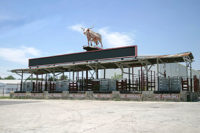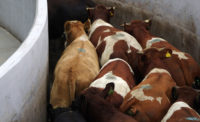In 2015, 96 humane handling enforcement actions were posted to the U.S. Department of Agriculture’s Food Safety and Inspection Service (FSIS) Web site. A closer look at the data revealed a shift in regulatory action and the need for continued focus on stunning.
Summary
Cattle, swine, sheep, and goats were represented in the 96 letters published in 2015. The majority of enforcement actions were documented in cattle facilities (50.5 percent). Swine (38.9 percent), sheep (7.4 percent) and goats (3.2 percent) represented the remaining percentage. Cattle and swine, by far, are the two most common groups of livestock that are slaughtered for red meat in the U.S. The prevalence of beef and pork slaughter in the U.S. was a likely contributor to the fact that the majority of enforcement actions (89.4 percent) occurred in beef and pork slaughter establishments in 2015.
Regulatory choices
The Humane Slaughter Act of 1978 (7 U.S.C. §§ 1901) and the regulations that enforce it (9 CFR 313) provide the framework for regulating the humane handling and stunning of red meat species. The regulations in 9 CFR 313 can be divided into three primary categories: 1) stunning; 2) handling; and 3) facilities. In 2015, 93.8 percent of the 96 enforcement actions were related to stunning and the remaining 6.3 percent involved handling issues. No facility-related notices of intended enforcement (NOIEs) or suspensions were issued up to Dec. 28, 2015.
In the event of an alleged violation of 9 CFR 313, one of two primary enforcement actions is typically taken by FSIS. The first action is suspension, which terminates inspection services until the observed humane-handling issue is properly addressed. Once addressed, inspection is reinstated after a response is drafted, reviewed and approved by the district office.
The second action is an NOIE. This action constitutes a warning that acknowledges the existence of an infraction that must be addressed, but inspection is not suspended. If corrective action is not taken, an NOIE can develop into a suspension.
As of Dec. 28, 2015, 65.6 percent of enforcement actions were suspensions and 34.4 percent were NOIEs.
Handling
Of the six handling-related incidents, five were concerned with the unloading of animals from trailers to slaughter establishments. Three of the five violations involved abusive handling by livestock transporters. Ultimately, it is up to the plant’s discretion to assign company personnel to unload trailers or to allow for truckers to perform this task. Once a load of livestock is in line to unload at a slaughter facility, the establishment takes full responsibility for the animals.
In general, improper handling, which involves excessive electric prod use and electric prod use on sensitive areas, kicking, hitting and misuse of handling aids and other tools such as PVC pipe and sticks, is regarded as abusive and must not be allowed. The types of handling events that resulted in enforcement actions in 2015 fit the description of “willful acts of abuse” in the North American Meat Institute’s Recommended Animal Handling Guidelines and Audit Guide, the guiding document for the majority of humane handling and stunning auditing programs in North America.
Three of the six handling-related incidents involved the improper treatment of downer or non-ambulatory animals, including excessive electric prod use, dragging of conscious animals, and dropping of animals off the back of trailers. It is critical that non-ambulatory animals are either euthanized on the spot or carefully moved to a suspect pen to allow for rest and recovery. In the case of cattle, euthanasia is the most common choice. For pigs, sheep, lambs, goats and calves, movement to a suspect pen is an option, but the animal must not be dragged. An appropriate sled or bucket must be used to transport the animal.
When making the decision to euthanize or move an animal to a suspect pen, it is important to identify the general cause of the animal’s state. If it is the result of a broken leg, prompting the animal to walk to slaughter on that broken leg will result in enforcement action from the FSIS. If an attempt is made to help an animal to its feet, it is important to lift smaller livestock by the body and not by the wool, hair or ears.
Stunning
In 2015, 90 of 96 (93.8 percent) enforcement actions detailed ineffective stunning procedures. Mechanical stunning procedures contributed 90.5 percent of enforcement actions related to ineffective stunning and electrical stunning included the remaining 9.5 percent. Both mechanical and electrical stunning methods are highly effective given that the animal is properly restrained, equipment is well-maintained, enough power is used and stuns are placed appropriately by well-trained individuals. The importance of training and maintenance cannot be overemphasized when it comes to stunning. The majority of stunning-related noncompliance can be avoided with effective training and maintenance.
As part of daily preventive maintenance for stunning equipment, the contact electrodes on electrical stunners should be kept in clean condition by using a wire brush or emery cloth to polish them when opportunities occur — such as between groups of animals or at scheduled breaks. Before cleaning the electrodes, the stunner must be completely turned off and locked out for worker safety. On a regular basis, electrical stunner performance should be checked by measuring voltage and amperage output under load. Many newer stunners have built-in monitoring systems, but older and simpler systems may require the use of a multimeter and current clamp by a trained and qualified person.
Mechanical stunning equipment should be kept clean, dry and appropriately lubricated per manufacturer’s specification. Powder cartridges must be kept absolutely dry — any moisture exposure can reduce their power output and potentially damage a captive bolt stunner as moisture present during powder combustion can result in corrosion and pitting of internal components. It is very important to keep handheld captive bolt guns warm during cold weather to prevent the development of condensation that will cause the gun to rust and deteriorate.
A shift in action
Comparing the enforcement actions of 2014 with 2015 revealed a shift in the occurrence of NOIEs and suspensions. In 2014, 19.4 percent of humane handling and stunning-related enforcement actions were NOIEs. In 2015, that number climbed to 34.4 percent.
In 2011, FSIS Directive 6900.2, Revision 2, laid out the specifications for the HACCP-based Systematic Approach to Animal Welfare. A systematic approach allows a slaughter establishment to develop a history of humane handling and stunning records that can be used to identify opportunities for improvement, track progress or serve as evidence that a humane handling or stunning incident was an anomaly. A plant that does not have a robust systematic approach installed does not receive the benefit of the doubt when a potential humane handling or stunning violation occurs. In many cases, the difference between a difficult and costly suspension and a NOIE is the ability to make a case that the event that occurred is not normal. A systematic approach isn’t a guarantee that all humane handling and stunning enforcement actions will be NOIEs, but it can come very close if the program is used with continuous improvement in mind. NP







Report Abusive Comment